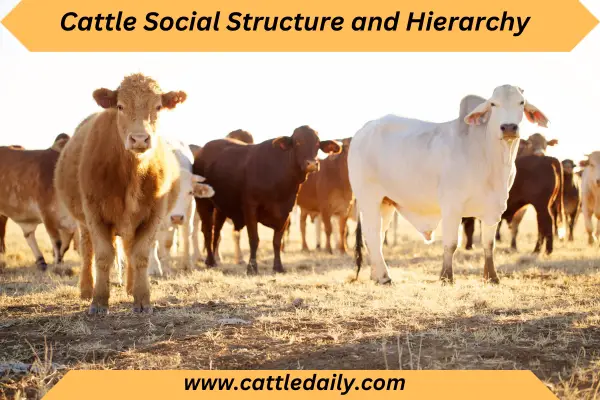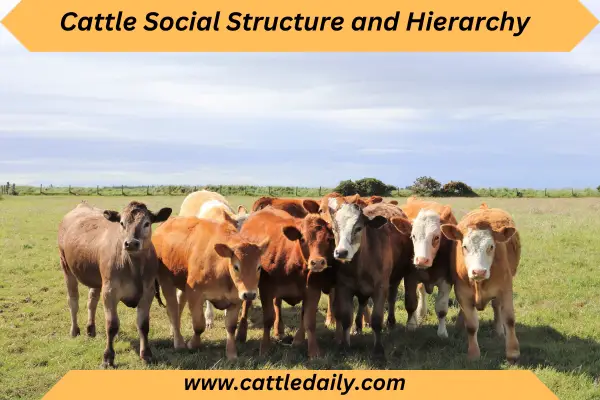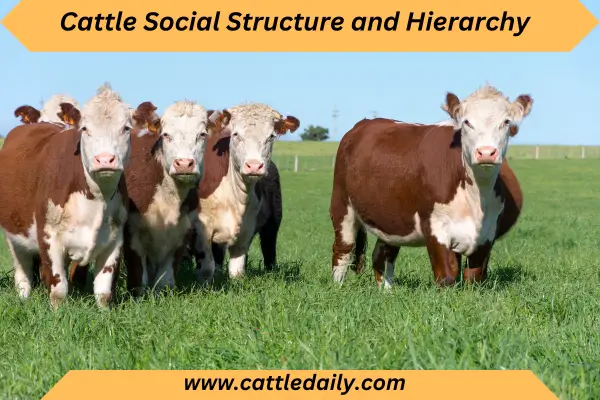Cattle Social Structure and Hierarchy
Cattle are highly social animals that live in complex social groups called herds. Within these herds, cattle establish a social hierarchy that determines the order of priority and access to resources like food, water, and mates.
Understanding the social structure and hierarchy in cattle herds is important for cattle owners and ranchers to ensure harmony and productivity.
In this blog article, we will discuss and explore the factors and features of social structure and hierarchy in the cattle herd.
What is a Cattle Herd?
A cattle herd refers to a group of cattle that live, travel, and graze together. Herds can range in size from just a few animals to several hundred. The herd provides safety, socialization, and effective foraging for resources.
Within the herd, there is a social hierarchy, bonds between individual animals, and social roles that cattle take on to ensure the cohesion and survival of the group.
Herds are often divided into smaller groups during grazing and resting periods but will regroup when it is time to travel again.
Key Features of Cattle Herds
Here are some of the main structural elements of cattle herds:
- Dominance Hierarchy – The herd has a linear dominance hierarchy where each member has a ranking position. The top-ranked cattle act as leaders.
- Membership Fluidity – Herd membership can change as cattle leave to join other herds or are ejected by dominant cattle. New cattle may also join the herd.
- Synchronized Activities – The herd moves, grazes, and rests together. Their behavior is synchronized.
- Social Facilitation – The presence of the herd facilitates basic activities like feeding and resting. Social bonds reduce stress.
- Social Learning – Knowledge and skills are passed down through observation of herd members, especially from mother to calves.
- The division into Subgroups – During grazing and resting, the herd splits into smaller subgroups by gender, age, and social bonds.

Cattle Dominance Hierarchy
At the core of the social structure of cattle herds is the dominance hierarchy. This determines which animals have priority access to food, water, shelter, and mates.
The dominance hierarchy is established through aggressive interactions and competition.
- Dominant cattle occupy the highest ranks and have first access to resources. They act as herd leaders and decision-makers.
- Subdominant cattle have middle ranks and get access after the dominants are finished.
- Submissive or subordinate cattle occupy the lowest ranks and get access to resources last after all the others.
Hierarchy Position Factors
These key factors influence an animal’s position in the dominance hierarchy:
- Age – Mature cattle tend to dominate younger cattle.
- Size – Larger animals are typically more dominant over smaller herd mates.
- Horns – Horned cattle are more likely to be dominant over polled (hornless) cattle.
- Time in Herd – Cattle that have been in the herd longer usually dominate newcomers.
- Breed – Some breeds like Brahman, tend to be more dominant.
- Personality – Shyer, docile cattle are subordinate to bold, confident herd mates.

Establishing Dominance
When new cattle join the herd or young animals reach maturity, the hierarchy has to be reestablished. This involves cattle engaging in aggressive interactions like butting heads and fights. The winner earns a higher rank.
Displays of dominance like staring, low head postures, chasing, and neck wrestling also occur. Once ranks solidify, overt aggression reduces as cattle learn their place.
Benefits of Position
Higher-ranking cattle benefit by getting first pick of food, shade, and resting spots. During travel, dominant cattle lead the herd while subordinate members trail behind.
Dominant cattle have better mating opportunities as they can displace competitors from estrous females. Their offspring also inherit the protective status.
Herd Leadership
At the top of the hierarchy are the herd leaders. The mature dominant females act as primary leaders and decision makers, while the alpha bull takes charge of discipline and protecting the herd.
Leaders initiate movements in grazing directions and resting places. They also direct the herd’s response in case of threats from predators. Leadership may change during herd splits.
Gender Hierarchy
Mature males tend to dominate females of a similar age, especially when competing for mating opportunities. But adult females can also displace less dominant bulls from food sources.
Among cows there is a linear hierarchy based on factors like age, size, and aggressiveness. More dominant cows have social priority over subordinate herd mates.
Mother-Offspring Bonds
Cattle form maternal solid bonds between mothers and their calves. Cows become highly protective of their calves after birth. The bond lasts through the calf’s first year when it is weaned.
Their mother’s status protects calves in the herd. As the calves mature, they gradually establish their own position in the hierarchy through interactions with other herd members.

Social Roles
Certain herd members take on special roles that contribute to the cohesion and function of the cattle herd. These include:
- Sentinels – These cattle keep watch for predators and threats while the herd is grazing or resting. They warn the herd to flee.
- Minders – Adult female cattle that look after calves of other herd members if their mothers wander off or pass away.
- Scapegoats – Low-ranking cattle that act as targets for aggression from other frustrated herd mates. This reduces conflict in the rest of the group.
Understanding Social Complexity
Cattle form intricate social relationships and networks within the herd structure. Knowledge of cattle social behavior helps farmers and ranchers manage herds in ways that minimize conflict and stress for maximum productivity.
Proper herd management should aim to maintain the natural social order. Actions like randomly mixing cattle from different groups or housing less dominant animals with very aggressive ones may disrupt the social balance.
Observing natural herd dynamics and hierarchy positions allows producers to group cattle incompatible sets. This results in herds that work together as a cohesive unit.
Human Intervention in Cattle Herds
While cattle naturally form social hierarchies, human management practices can influence herd structure and dynamics in various ways.
- Early Weaning – Separating calves from mothers earlier than the natural weaning age (6-9 months) disrupts critical social bonds.
- Dehorning – Removing horns diminishes the social status of cattle compared to horned herd mates.
- Solitary Housing – Isolating single cattle prevents normal social behavior and causes stress.
- Regrouping – Randomly mixing unfamiliar cattle frequently disrupts the hierarchy and causes aggression.
- Overcrowding – Having too high a cattle density can lead to excessive competition and fighting.
Avoiding these practices when possible allows calves to mature socially and establish stable bonds. This creates calm, productive cattle herds.
Conclusion
Cattle are highly social herd animals that depend on coordinated group living for their survival. Each herd develops a linear dominance hierarchy through aggressive interactions and resource competition.
Understanding the social structure and hierarchy roles in cattle herds gives producers insights to improve cattle handling and management practices. Maintaining a herd’s natural social order reduces conflict and stress for better animal welfare and productivity.
Human intervention should aim to nurture cows’ maternal bonds, allow normal weaning, provide adequate space, and avoid excess mixing of unfamiliar cattle. This results in cohesive, harmonious cattle herds. Learn here more about cattle behaviours and its understanding.


